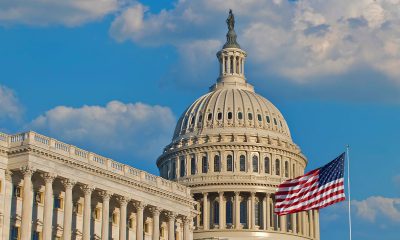Bay Area
State to End Indoor Mask Requirement in Health Care Facilities, Vaccine Requirement for Health Care Workers
California will draw down several COVID-19-related guidelines next month as the state shifts out of its emergency response to the pandemic, state health officials said Friday. Starting April 3, the state will no longer require the use of a mask in indoor areas that are deemed a high risk of transmission, including health care and long-term care facilities, homeless shelters and jails and prisons

By Eli Walsh
Bay City News
California will draw down several COVID-19-related guidelines next month as the state shifts out of its emergency response to the pandemic, state health officials said Friday.
Starting April 3, the state will no longer require the use of a mask in indoor areas that are deemed a high risk of transmission, including health care and long-term care facilities, homeless shelters and jails and prisons.
The state will also end its COVID vaccination requirement for health care workers and rescind health orders that required hospitals to accept patients from overcrowded facilities and that required the collection of an email address or phone number from a COVID vaccine recipient.
“We stand before Californians today with a humble message of thanks for taking the hard steps to help manage COVID-19, and with an ongoing commitment to be prepared for what comes next,” California Department of Public Health Director and state Public Health Officer Dr. Tomas Aragon said in a statement.
In addition to the changes on April 2, the state will update its isolation guidance on March 13 for those who test positive for COVID, allowing them to leave isolation after five days if their condition is improving and if they have not had a fever in at least 24 hours.
People who isolate after testing positive will no longer have to test negative for COVID before leaving isolation, according to the CDPH. The change is consistent with guidance from the U.S. Centers for Disease Control and Prevention.
The changes are part of the state’s drawdown of its emergency response infrastructure in recent weeks.
State-operated COVID testing and vaccination clinics have shuttered as those services shift to primary health care providers and retail pharmacies.
On Tuesday, Gov. Gavin Newsom also rescinded California’s COVID-19 state of emergency, which allowed local governments and the state to more efficiently coordinate public health programs and disperse emergency funding.
State public health officials continue to urge California residents to complete their initial COVID vaccination series if they have yet to do so and, if eligible, receive a booster vaccine dose to reduce the chance of becoming seriously ill or dying due to the virus.
As of March 2, 88.2 million COVID vaccine doses have been administered statewide. Roughly 73 percent of state residents have completed their initial vaccination series.
“Our communities did a lot of the hard work by getting vaccinated and boosted, staying home and testing when sick, requesting treatments when positive, and masking to slow the spread,” Aragon said. “With these critical actions, and a lot of patience and persistence, we have now reached a point where we can update some of the COVID-19 guidance to continue to balance prevention and adapting to living with COVID-19.”
Copyright © 2023 Bay City News, Inc. All rights reserved. Republication, rebroadcast or redistribution without the express written consent of Bay City News, Inc. is prohibited. Bay City News is a 24/7 news service covering the greater Bay Area.
###
EliWalsh2132p03/03/23
CONTACT: CDPH media CDPHpress@cdph.ca.gov
EDITORS PLEASE NOTE: An image related to this story can be obtained from the following Bay City News Service web link: https://www.baycitynews.com/images/BCN-20221209-VACCINATION-01.JPG
Caption: The CVS Drugstore on Mountain Blvd. in Oakland, Calif on Dec 8, 2022 offers vaccination and COVID test kits to customers. (Anna Moseidjord/Bay City News)
/www/bcn/general/03/newsclip.23.03.03.21.34.01.1.txt
Alameda County
Seth Curry Makes Impressive Debut with the Golden State Warriors
Seth looked comfortable in his new uniform, seamlessly fitting into the Warriors’ offensive and defensive system. He finished the night with an impressive 14 points, becoming one of the team’s top scorers for the game. Seth’s points came in a variety of ways – floaters, spot-up three-pointers, mid-range jumpers, and a handful of aggressive drives that kept the Oklahoma City Thunder defense on its heels.

By Y’Anad Burrell
Tuesday night was anything but ordinary for fans in San Francisco as Seth Curry made his highly anticipated debut as a new member of the Golden State Warriors. Seth didn’t disappoint, delivering a performance that not only showcased his scoring ability but also demonstrated his added value to the team.
At 35, the 12-year NBA veteran on Monday signed a contract to play with the Warriors for the rest of the season.
Seth looked comfortable in his new uniform, seamlessly fitting into the Warriors’ offensive and defensive system. He finished the night with an impressive 14 points, becoming one of the team’s top scorers for the game. Seth’s points came in a variety of ways – floaters, spot-up three-pointers, mid-range jumpers, and a handful of aggressive drives that kept the Oklahoma City Thunder defense on its heels.
One of the most memorable moments of the evening came before Seth even scored his first points. As he checked into the game, the Chase Center erupted into applause, with fans rising to their feet to give the newest Warrior a standing ovation.
The crowd’s reaction was a testament not only to Seth’s reputation as a sharpshooter but also to the excitement he brings to the Warriors. It was clear that fans quickly embraced Seth as one of their own, eager to see what he could bring to the team’s championship aspirations.
Warriors’ superstar Steph Curry – Seth’s brother – did not play due to an injury. One could only imagine what it would be like if the Curry brothers were on the court together. Magic in the making.
Seth’s debut proved to be a turning point for the Warriors. Not only did he contribute on the scoreboard, but he also brought a sense of confidence and composure to the floor.
While their loss last night, OKC 124 – GSW 112, Seth’s impact was a game-changer and there’s more yet to come. Beyond statistics, it was clear that Seth’s presence elevated the team’s performance, giving the Warriors a new force as they look to make a deep playoff run.
Activism
Oakland Post: Week of November 26 – December 2, 2025
The printed Weekly Edition of the Oakland Post: Week of November 26 – December 2, 2025

To enlarge your view of this issue, use the slider, magnifying glass icon or full page icon in the lower right corner of the browser window.
Activism
Oakland Post: Week of November 19 – 25, 2025
The printed Weekly Edition of the Oakland Post: Week of November 19 – 25, 2025

To enlarge your view of this issue, use the slider, magnifying glass icon or full page icon in the lower right corner of the browser window.
-

 Activism3 weeks ago
Activism3 weeks agoOakland Post: Week of November 12 – 18, 2025
-

 Activism4 weeks ago
Activism4 weeks agoOakland Post: Week of November 5 – 11, 2025
-

 Activism2 weeks ago
Activism2 weeks agoIN MEMORIAM: William ‘Bill’ Patterson, 94
-

 Activism3 weeks ago
Activism3 weeks agoHow Charles R. Drew University Navigated More Than $20 Million in Fed Cuts – Still Prioritizing Students and Community Health
-

 #NNPA BlackPress3 weeks ago
#NNPA BlackPress3 weeks agoThe Perfumed Hand of Hypocrisy: Trump Hosted Former Terror Suspect While America Condemns a Muslim Mayor
-

 Bay Area3 weeks ago
Bay Area3 weeks agoNo Justice in the Justice System
-

 #NNPA BlackPress3 weeks ago
#NNPA BlackPress3 weeks agoProtecting Pedophiles: The GOP’s Warped Crusade Against Its Own Lies
-

 #NNPA BlackPress2 weeks ago
#NNPA BlackPress2 weeks agoTrump’s Death Threat Rhetoric Sends Nation into Crisis

























































